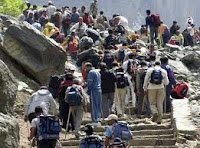Demonetisation or note ban
after over one hundred days face a tough challenge to settle whether the November
8, 2016 political masterstroke succeeded to achieve economic goals and
political results or lost ground to its failure. But there is a silent anguish
among women against the Government’s inability to acknowledge and appreciate
the active participation by all urban as well as rural housewives,
service-class and professionals with their complete involvement in the
banking exercise in long endless queues for indefinite hours to ensure ‘Black
Money’ is unearthed.
The Economic Survey
admitted that demonetization created uncertainty and immediate adverse impact
and hinted to reports of some job losses, decline in farm incomes and social
disruptions. It also noted that RBI should take steps to remove the fears, if
any people may have about using or withdrawing cash. Initially, it looked
demonetisation was targeted to demolish black money and eliminate use of
counterfeit currency by the terrorist outfits. If the demonetisation hit hard
any one it really were the women across the country.
Every woman searched their lockers,
suit-cases, purses thoroughly and even didn’t spare children’s piggy banks and
went for voluntary disclosures to surrender each big note of their ‘secret
savings’. Women amidst post-demonetisation joined their
men and accompanied them to ATMs even at late night to ensure two withdrawals. Woman
claim despite repeated dis-appointments they didn’t care to return home empty
handed time and again. It was their earnest effort to ensure deposit old notes limited
to 4500 rupees and withdrawal of remonetized new currency notes limit set at
2000 rupees in a peaceful manner.
Women suffered fatigue,
stress and spend sleepless nights in standing in long endless queues for indefinite
hours without water, food and didn’t care about children. Their participation in
queues demonstrated discipline and ensured peace in maximum crowded places. Women
managed banking (deposit & withdrawals) & ‘kitchens’ together. Ms Suman
Ranola, an Architect said, “We collected each note in the family and did not even
spare children’s piggy-banks to avoid wastage. Our savings have finished and
came to zero. Who appreciated our efforts”? Women suffered due to severe
shortage and non-availability of new currency. The entire exercise was exhaustive
and worrisome as the deposits, limited to 4500 were to be complete within the
stipulated period of 50 days and these old notes were valid for some limited
Govt. agencies and
consumer supply points like chemists, milk-booths and other
essentials.
Except some clashes, the
entire banking process (deposits & withdrawal) in first 50 days in
post-demonetisation over all remained peaceful and possibly credit goes to
women participation. There were some deaths, 100 or so who died for either
natural or routine medical reasons developed for staying overtime in queues.
Women came out, joined long
endless queues, voluntarily to deposit or withdraw money and preferred men to
attend or continue with routine or vice versa. On the contrary, men from every
family joined ‘mission withdrawals’ cash from ATMs after office hours late
night subject to cash availability. In reply to a question Ms Sumika R
Aggarwal, Ex-Manger HDFC bank replied, “Demonetisa- tion seemed a decision in
haste and without complete home work. RBI seems didn’t anticipate the practical
difficulties in cash withdrawals. Mis-management, long queues and cash crunch
in banks/ ATMs really worsened the scene. Govt. didn’t appreciate women efforts”.
To arrange extra-cash, being
marriage season one had to struggle and run from pillar to post. While offering
her views, Dr. Seneha Santoshi, Assistant Prof. Amity University said, “To unearth
Black Money was an excellent idea but mis-management at banks, deposit &
withdrawals wasted our precious hours. Our salary accounts got reduced to instalments
of 2000 rupess”. Whereas another, academician Amity University Dr. Sheetal
Shirodhkar, Assistant Prof. (AP-II)
claimed, “The females lost all the money they had kept aside secretly. They can
no more slide a few notes in their secret savings”.
After 100 days of demonetisation
and pumping of remonetized new currency 2000 rupee notes the situation is yet
to return to normal. RBI may succeed to do so by the end of March’17 in urban
areas but it will certainly take some more time for rural areas and villages. Around
100 precious lives have been lost between November 9 and December 30 and some opposition
parties demanded compensation for the families, who lost their dear one’s
standing in queues for hours without food and water outside banks/ATMs. Another
banker, Ms Vatsala Gupta, Sr. Manager, Yes Bank Corporate Office straight forwardly
remarked, “Housewives have lost all confidence in saving cash. We will go
digital in saving
secretly now depending upon the future circumstances”.
Now, the RBI/Govt. pushes to
shift to cashless economy, e-banking, Paytm’s or other available apps, today.
But an IT professional, Kanika Khurana, Application Analyst commented, “Demonetisation
robbed us of all energy and hard-earned ‘secret savings’. I doubt, if cashless,
Paytm or other apps will pick up immediately. This will take some more time”.
Today, every family faces a
valid question as how to restore financial lordship to women, the real ‘Home Makers’ and it couldn’t
be possible in the past 100 days of demonetization. No doubt, e-banking is
already there in use and to give priority to new apps. as Paytms etc. than
cash-system it needs us to give a helping hand to our life-partners as Govt. promotes
cashless. However, it seems appropriate for Govt. to recognize and appreciate women’s
role played particularly in first 50 days
to neutralise the anguish. Today, women in routine interaction charge that demonetisation
proved a big tool to reduce them to zero.



































